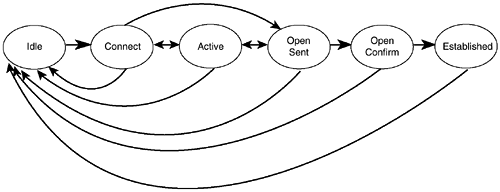Forming a BGP Connection
| < Free Open Study > |
| BGP uses TCP/IP as its underlying transport and uses TCP port 179. BGP speakers transition through various states during the establishment of a neighbor relationship, as shown in Figure A-10. Figure A-10. States in the Formation of a BGP Neighbor Relationship The Idle state usually represents the condition in which BGP has not been enabled on the router, or a particular neighbor relationship has been shut down. When a connection is initiated through either router configuration or the removal of the shut-down state for a particular neighbor, BGP moves to the Connect state. In the Connect state, BGP waits for a TCP connection to be established with the remote neighbor. If the TCP connection is established, an Open message is sent, and the Open Sent state is entered. If the TCP connection is not established, the Active state is entered. While in the Active state, the router continues to listen for a connection. In the Open Sent state, the router waits for an Open message from the remote neighbor. If there are errors in the Open message, a notification message is sent to the neighbor, and the local router enters the Idle state. If the Open message contains no errors, a keepalive message is sent, and the holdtime is set to the negotiated value. The Open Confirm state is then entered. If the BGP neighbors are in the same AS, the BGP connection is internal. If the BGP neighbors are in different autonomous systems, the connection is external. In the Open Confirm state, BGP waits for a keepalive or notification message. If a keepalive message is received, the connection moves to the Established state. If a keepalive message is not received before the hold timer expires , a notification message is sent, and the state transitions to Idle. In the Established state, the BGP neighbors can exchange update, notification, and keepalive messages. Whenever BGP changes its state from Established to Idle, it closes the BGP and TCP connection, releases all resources associated with that connection, and deletes all routes derived from that connection. Table A-3 lists additional references available from http://www.nexor.com/index-rfc.htm Table A-3. BGP-Related RFCs
|
| < Free Open Study > |
EAN: 2147483647
Pages: 300
